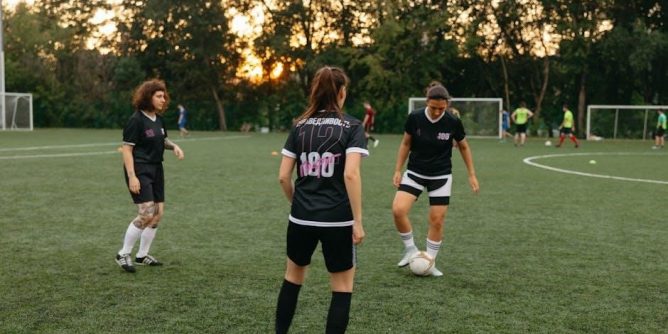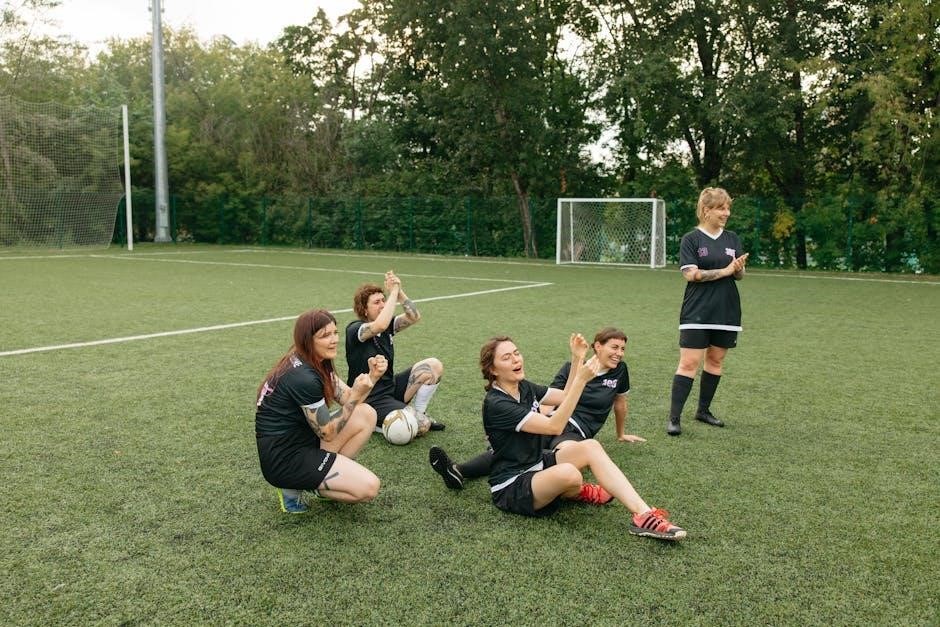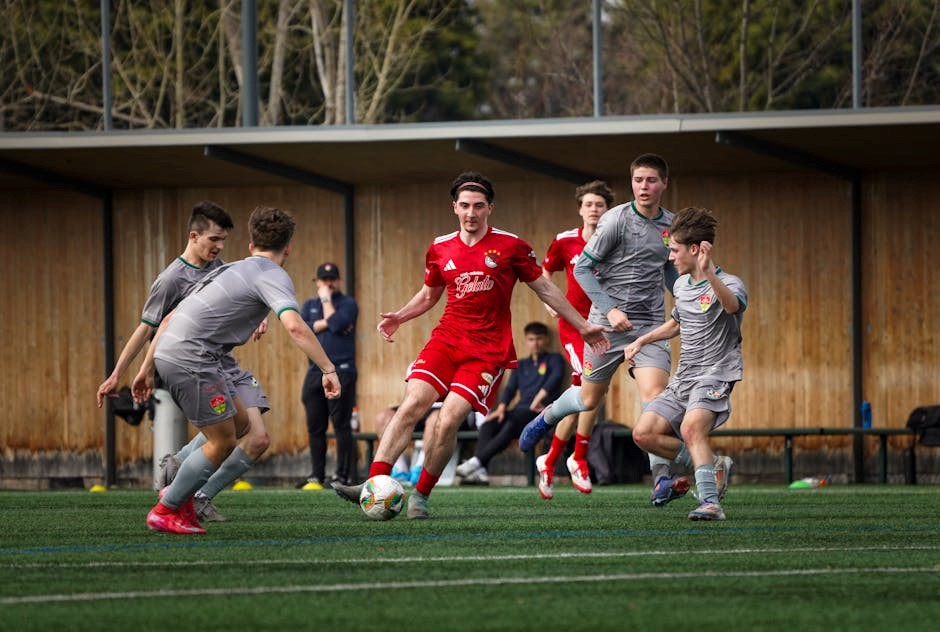
A well-structured soccer fitness program is essential for enhancing performance, building endurance, and preventing injuries․ It combines aerobic and anaerobic exercises with strength training to optimize player potential․

1․1 Importance of Structured Fitness Training in Soccer
Structured fitness training is crucial for soccer players to enhance performance, prevent injuries, and maintain peak physical condition․ A well-designed program ensures players develop the endurance, strength, and agility needed for the demands of the game․ It helps improve cardiovascular health, muscular endurance, and speed, all of which are essential for sustained performance over 90 minutes․ Additionally, structured training allows players to build specific skills, such as sprinting, dribbling, and quick changes of direction, which are vital for outperforming opponents․ Consistency and progressive overload in training routines ensure steady improvement and adaptation to the physical demands of professional soccer, making structured fitness training indispensable for aspiring players aiming to reach elite levels․
1․2 Overview of the 6-Week Pro Soccer Fitness Training Program
The 6-week pro soccer fitness training program is a comprehensive plan designed to elevate players’ physical fitness to professional standards․ It combines aerobic and anaerobic conditioning, strength training, and speed drills to build endurance, power, and agility․ The program is structured to progressively increase intensity, ensuring players adapt to the demands of high-level soccer․ Each week focuses on specific goals, such as improving cardiovascular health, enhancing muscular endurance, and refining technical skills․ Customizable for individual needs, the program allows players to adjust workout routines based on their fitness levels and objectives․ By following this structured approach, aspiring professionals can achieve significant improvements in their overall soccer fitness, preparing them for trials, pre-season training, or competitive play․

Components of a Soccer Fitness Program
A soccer fitness program includes aerobic and anaerobic conditioning, strength training, speed drills, and flexibility exercises․ These components enhance endurance, power, agility, and overall athletic performance․
2․1 Aerobic and Anaerobic Conditioning
Aerobic conditioning focuses on building endurance through exercises like distance running and high-intensity interval training, improving cardiovascular health and stamina․ Anaerobic conditioning, on the other hand, enhances short-burst energy for sprints and explosive movements․ Both are crucial for soccer, as players need sustained energy for the full 90 minutes and quick bursts of speed to outpace opponents․ The program integrates these elements to optimize performance, ensuring players can maintain intensity throughout the game․ Proper conditioning also reduces injury risk and enhances recovery․ By balancing aerobic and anaerobic training, players achieve a well-rounded fitness level tailored to the demands of professional soccer․
2․2 Strength and Speed Training
Strength and speed training are fundamental components of a soccer fitness program, designed to enhance power, agility, and acceleration․ This phase focuses on building muscular endurance and explosive energy through exercises like weightlifting, plyometrics, and resistance band workouts․ Speed drills, such as sprints and shuttle runs, improve acceleration and deceleration, essential for outpacing opponents․ Core and leg strength are prioritized to stabilize movements and generate force during kicks and jumps․ These exercises not only boost physical performance but also reduce injury risks by strengthening key muscle groups․ The program emphasizes functional strength, ensuring that every workout translates to real-game scenarios, helping players dominate on the field with precision and power․
2․3 Flexibility and Mobility Exercises
Flexibility and mobility exercises are crucial for soccer players to maintain optimal range of motion and reduce injury risk․ These exercises focus on stretching major muscle groups, such as hamstrings, quadriceps, and hip flexors, while improving joint mobility․ Dynamic stretching, yoga, and foam rolling are common techniques used to enhance flexibility․ Incorporating these exercises into daily routines ensures better movement efficiency and posture․ Mobility drills, like leg swings and high knees, prepare muscles for intense activity․ By improving flexibility, players can perform soccer-specific movements, such as kicking and changing direction, with greater precision and power․ Regular practice also promotes faster recovery and long-term physical resilience, making it a cornerstone of any comprehensive fitness program․

Benefits of the 6-Week Training Program
This program prepares players for professional soccer trials, enhances performance, and improves fitness levels․ It builds endurance, strength, and agility, helping athletes achieve professional-level conditioning and readiness․

3․1 Preparing for Professional Soccer Trials
The 6-week soccer fitness program is specifically designed to prepare aspiring professionals for the demands of soccer trials․ It focuses on building the endurance, strength, and agility required to compete at the highest level․ By following the structured workouts, players can improve their aerobic and anaerobic conditioning, ensuring they meet the physical demands of professional soccer․ The program also emphasizes injury prevention and mental toughness, key factors for success in trials․ With a clear progression of exercises, individuals can track their improvement and adjust routines to address weaknesses․ This comprehensive approach ensures athletes are both physically and mentally prepared to excel in professional soccer trials and stand out among competitors․
3․2 Enhancing Overall Soccer Performance
The 6-week soccer fitness program is tailored to enhance every aspect of a player’s performance, from endurance to agility․ By focusing on aerobic and anaerobic conditioning, players build the stamina needed to maintain intensity over 90 minutes․ Strength and speed training improve power and acceleration, allowing for sharper sprints and faster reactions․ Flexibility and mobility exercises ensure fluid movement and reduce injury risks․ The program’s structured progression helps players develop a well-rounded physical foundation, enabling them to excel in all phases of the game․ This holistic approach not only boosts physical capabilities but also mental toughness, giving players the edge to outperform opponents and achieve peak performance on the field․

Customizing the Training Program
The program allows for personalized adjustments, enabling users to tailor workouts to their fitness levels and goals, ensuring optimal progress and performance․

4․1 Adjusting Workout Routines for Individual Needs
Customizing the workout routines is crucial for maximizing effectiveness․ Users can modify exercises based on their fitness levels and goals, ensuring a personalized approach․ The program allows for adjustments in intensity, duration, and frequency to suit individual needs․ For example, beginners may reduce the intensity of anaerobic workouts, while advanced players can increase the difficulty․ Additionally, incorporating rest days and recovery sessions helps prevent overtraining․ Coaches and individuals can track progress weekly and make further adjustments to maintain momentum․ This flexibility ensures the program remains challenging yet achievable, catering to diverse fitness objectives and promoting consistent improvement․ Regular assessments and modifications are key to long-term success․
4․2 Monitoring Progress and Making Adjustments
Regularly monitoring progress is vital to ensure the effectiveness of the training program․ Tracking fitness levels, workout consistency, and performance improvements helps identify areas for adjustment․ By assessing metrics such as endurance, strength, and agility, individuals can gauge their development․ Coaches and players can use this data to fine-tune the program, increasing intensity or focusing on specific skills as needed․ Adjustments may include modifying exercise duration, frequency, or type to better align with goals․ Incorporating feedback and maintaining a balanced approach ensures continuous improvement․ Utilizing tools like progress logs or fitness apps can streamline this process․ Consistent monitoring and timely adjustments are essential for achieving optimal results and maintaining motivation throughout the program․

A well-structured soccer fitness program enhances performance, builds endurance, and prevents injuries․ Consistency and proper adjustments ensure players achieve their fitness goals and excel at professional levels․
5․1 Final Thoughts on Achieving Soccer Fitness Goals

Achieving soccer fitness goals requires dedication, consistency, and a well-structured program․ By focusing on aerobic and anaerobic conditioning, strength training, and flexibility, players can optimize their performance․ Monitoring progress and adjusting routines ensures continued improvement․ Emphasizing proper nutrition, recovery, and mental preparation further enhances results․ A 6-week program provides a clear roadmap, but long-term success depends on maintaining discipline and adapting to individual needs․ With persistence and the right guidance, aspiring players can reach professional fitness levels and excel in their soccer careers․